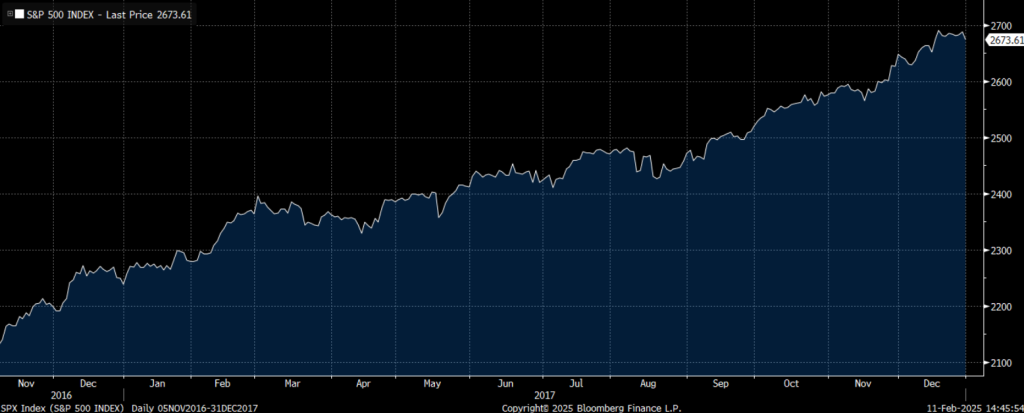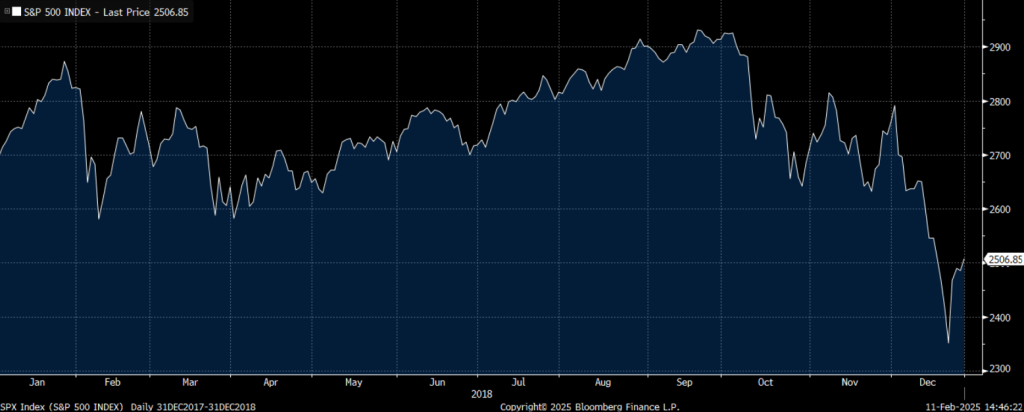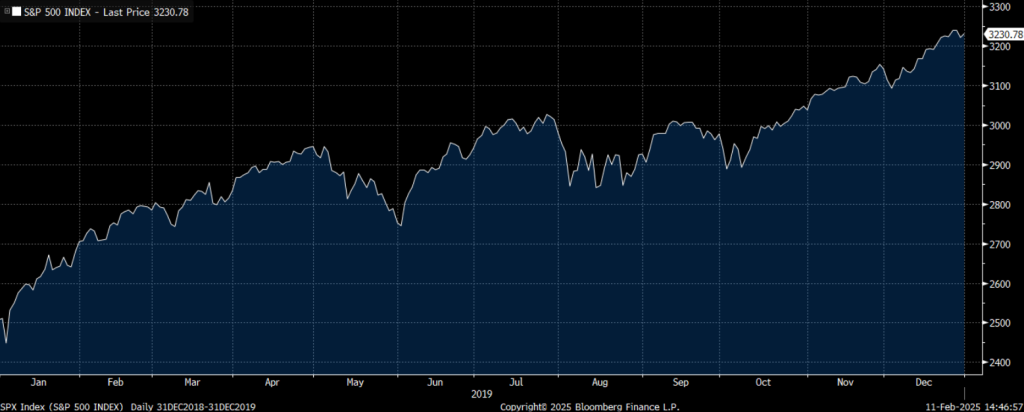Editor’s note: “Wall Street Under Trump: Highlighting History to See What’s Ahead” was previously published in November 2024 with the title, “Market Watch: How Trump’s Tariff Strategy Could Reshape This Rally.” It has since been updated to include the most relevant information available.
Ever since Donald Trump won the 47th U.S. presidential election, the market has been on a roller-coaster ride. Stocks are back-and-forth on deregulation hopes, tariff drama, and geopolitical tensions, among other things.
It has been an eventful three months.
Of course, after such an eventful start to Trump’s second term, a lot of folks are asking the question: What will the next four years be like for the stock market?
Fortunately, we don’t have to guess how a Trump presidency will impact stocks. We can just look back at how stocks did throughout 2017, ‘18, and ‘19 to determine how they may perform over the next few years. (Note: we’re excluding 2020 from this analysis due to the COVID-19 pandemic, a unique phenomenon unlikely to repeat in the next four years.)
So – how did stocks do in the Trump 1.0 era?
In short, they soared in 2017 on improved economic growth and lower taxes, then stumbled in 2018 as new tariffs arrived and caused reinflation. Stocks recovered in 2019 as tariffs eased, inflation fell, and the U.S. Federal Reserve cut rates.
And from where things stand today, a repeat of that performance seems quite possible.
A Lookback at the Era of Trump 1.0
Specifically, in 2017, we saw an immediate acceleration in GDP from 2% to 4.6%. This caused some reinflation, but not much. The market didn’t care. Economic reacceleration was the story of the year. Stocks soared.

But then the first big batch of tariffs arrived in early 2018 – and everything changed.
First, there were the 30% to 50% tariffs enacted on solar panels and washing machines in January. Then, in March, we got a 25% steel tariff and 10% aluminum tariff. Those escalated and expanded into June 2018.
Steel prices spiked by about 50% in the first half of 2018. Aluminum prices jumped around 30%. The entire Bloomberg Commodity Index – a strong gauge of all commodity prices – rose about 10% in the first half of 2018, mostly due to the tariffs increasing prices and stalling global trade.
And as a result, inflation started to become a problem once again. It rose from ~2% to ~3% in the first half of 2018, which forced the Federal Reserve to get more aggressive with its rate-hiking cycle. Indeed, the central bank hiked interest rates four times in 2018 to fight tariff-fueled reinflation.
Higher prices and higher rates weighed on the economy. GDP slowed from 4.6% at the end of 2017 to 0.6% at the end of 2018.
The combination of higher prices, higher rates, and falling growth spooked investors and led to a violent ~20% market crash between September and December 2018.

In response to the market volatility and slowing growth conditions, the Fed stopped hiking rates in early 2019. Simultaneously, Trump started rolling back certain tariffs, particularly steel and aluminum tariffs on Canada and Mexico.
Inflation eased. The Fed cut rates. The economy restrengthened, with GDP recovering to 4.8% by late 2019. And the stock market soared.

The Final Word on What’s Ahead for Stocks
So… in the Trump 1.0 era… we had a tug-of-war between faster economic growth and higher inflation, with inflation only becoming a problem when big tariffs arrived in 2018.
That is why investors and economists are so squarely focused on Trump’s tariff policy. There was a lot of talk on the campaign trail about big tariffs. Some of that talk has turned into walk. But not much has been enforced (yet), which is why stocks have been doing well in the Trump 2.0 era… so far.
Nonetheless, investors should remain vigilant.
For now, the market will push higher on optimism for pro-growth policies and lower corporate taxes, as it did in 2017.
But pay close to attention to what rhetoric turns into policy. If very little of the tariff talk becomes walk, this market could be on the launching pad for a few years.
We think that’s entirely possible.
For this reason, I put together an exclusive informational presentation in the wake of Donald Trump’s return to the White House and the groundbreaking partnership between his administration and Elon Musk’s ventures. I truly believe this could redefine your investment strategy for 2025 and beyond.
This presentation unpacks:
- Trump’s Policy Predictions: A five-point game plan for how his policies could shape the economic landscape, from tax reforms to infrastructure spending.
- Market Impacts: Analysis of how these policy changes might influence your money over the next four years, including when the boom becomes a bust.
- Investment Opportunities: I point you in the direction of the sectors best positioned for exponential growth, including those directly benefiting from Musk’s projects and Trump’s economic vision.
Considering the unique synergy between these two influential figures, this presentation isn’t just insightful—it’s potentially lucrative. I’ve poured countless hours into ensuring this content not only informs but also directs you toward some of the most promising stock picks for 2025.
Click here to watch now and better navigate this unprecedented political and economic climate.
On the date of publication, Luke Lango did not have (either directly or indirectly) any positions in the securities mentioned in this article.
P.S. You can stay up to speed with Luke’s latest market analysis by reading our Daily Notes! Check out the latest issue on your Innovation Investor or Early Stage Investor subscriber site.

